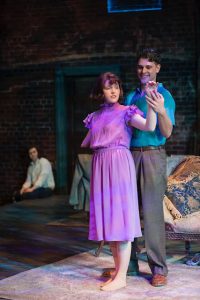
L-R Julie Fishell, Felipe Carrasco & Delaney Fleenor in The Glass Menagerie – Courtesy of Zach Rosing. Used with permission.
One thing is certain regarding my response to seeing Tennessee Williams’s classic “The Glass Menagerie.” It triggered memories my years of living with my family. Referred to as a memory play, the classic drama which shot Williams to fame, premiered on Broadway in 1944. Loosely based on the playwright’s own recollections from his youth, the play is presented at the Indiana Repertory Theatre on its Janet Allen Stage through April 6.

Felipe Carrasco in The Glass Menagerie – Courtesy of Zach Rosing. Used with permission.
All the events in “The Glass Menagerie” are drawn from the memories of the play’s narrator, Tom Wingfield (Felipe Carrasco), who is also a character in the play. The setting is the gloomy Wingfield apartment, located in a blue-collar tenement building in St. Louis and takes place in the 1930s. Tom, a restless, aspiring poet, who addresses the audience when the play begins, works in a warehouse to support his trapped in the past, Southern Belle, mother Amanda (Julie Fishell) and disabled, painfully shy sister, Laura (Delaney Feenor). A gentleman caller, Jim O’Conner, (Sam Bell Gurwitz) appears in the final scenes of the play. Tom and Laura’s father, who is frequently referred to as the fifth character, left the family many years ago. Apart from one postcard, there has been no other communication from him.
Tom and Laura’s father, often called the fifth character, abandoned the family years ago.

L-R Delane Fleenor & Sam Bell Gurwitz in The Glass Menagerie – Courtesy of Zach Rosing. Used with permission.
“Dysfunctional,” a word used to describe families struggling with toxic dynamics, has become part of our lexicon and Willliam’s play represents that such relationships have always existed. That makes the play one that still resonates with modern day audiences who experience the same themes such as family dynamics, illusion vs. reality, loneliness and acceptance of reality, explored in the timeless work.
Adroitly directed by former IRT playwright James Still, the ensemble, all of whom are making their IRT debut, turned in high caliber performances.
Carrasco was convincing as the frustrated dreamer who works in a warehouse and goes to the movies nightly and uses alcohol to escape his delusional mother, wounded sister, and reality in general.
Feenor, as Laura beautifully captured her character’s fragility and vulnerability of the submissive, damaged recluse, finding her own escape through her collection of glass figurines and standards played on an old victrola.
Ferrel was often brilliant in her vivid portrayal of Amanda, the family’s melodramatic, narcissistic matriarch show who is constantly reliving her past as a sought-after debutante. A precursor to William’s Blanch Dubois, a now iconic character he would later create in “A Streetcar Named Desire,” flighty Amanda is a role that Ferrel seemed born to play. I was especially amused by her aristocratic sounding Mississippi accent and cadence which featured breathless, sing songy, and sometime shrieking delivery.
It is rare that I have anything but positive to note regarding production elements and values of any IRT show as they are as high caliber as any on Broadway. This production is no exception. High praise goes out to Scenic Designer Edward to Norris for his depiction of the Winfeld’s dismal urban world, Costume Designer Yao Chen’s pitch perfect 30s era creations om works at a shoe warehouse to support his family but is frustrated by his job and aspires to be a poet. He struggles to write, all the while being sleep-deprived and irritable. Yet, he escapes from reality through nightly excursions to the movies. Tom feels both obligated toward yet burdened by his family and longs to escape., Lighting Designer Michelle Babeck’s forlorn atmosphere, Costume Designer Yao Chen’s pitch perfect 30s era clothes and Music Composer and Sound Designer Melanie Chen Cole’ suitable melancholic score.
The seasoned actors completely drew me into story that is anything uplifting but like a Hopper painting, one I appreciated the narrative for its depiction of loneliness and the need we all have for human connection, even within our own family units.
For tickets and information about “The Glass Menagerie” presented at Indiana Repertory Theatre visit irtlive.com





